🎹 UPDATED REVIEW – April 1, 2018 – Yamaha NU1 digital piano – Recommended – The compact (approx 40″ tall and 18″ deep) upright contemporary style Yamaha NU1 in polished ebony ($6999US store retail price) is what they call a “hybrid” model digital piano. This is because it has a real wood key action with wood keys, wood action parts, and other organic key action parts from a real acoustic vertical piano coupled with the piano sound being produced digitally through speakers (no strings attached:). The 40″ height of the piano means that it is a console size piano and not a real acoustic type upright which is normally considered 48″ tall.
| NU1 |
Since the #1 thing piano teachers, piano players, and shoppers generically look for first in a digital piano is key action realism as compared to a good acoustic piano, and the Yamaha NU1 in my opinion is a winner in that regard. I have played the NU1 and I personally like the upright key action very much and it is noticeably more realistic and enjoyable to play than the popular Yamaha Clavinova series of digital pianos. I would consider the action movement to be medium in key weight & resistance and moves up & down quite nicely and easily, although it is a vertical piano key action and not a grand piano key action. So when considering this model you need to keep that in mind as there are other digital piano brands out there which don’t have a traditional acoustic key action but yet in a lot of ways feel more like a grand piano. Although the on-line discount selling price of this piano is now $5999, I have found that the actual Yamaha store discount pricing is much closer to $5000 which is a good price depending on your local dealer and product availability, but it is still not inexpensive. With that price in mind you could instead purchase a new or very good late model used acoustic upright piano (in a variety of brands) for that same price or less and get a 100% real acoustic piano playing experience if that’s what you wanted. But there are obvious advantages to good name brand digital pianos and that’s why people buy them.
| NU1 key action |
So why would someone want a Yamaha NU1 digital piano instead of an acoustic upright piano anyway? Here are some reasons: it won’t go out of tune and that can save $100’s and even $1000’s of dollars over a lifetime of piano playing assuming you keep it for a long time…and as far as not going out of tune, it really is a pleasure to play a piano that is NOT out of tune especially if your ear is sensitive to “out of tune” pianos, like my ear is:). Eventually all acoustic pianos go out of tune and some more quickly than others depending on the local climate and particular piano, and then you’ve got to put out the money to get a good tuner (don’t want a bad one) over to tune it. So always being in perfect tune is a very good thing! Another advantage to digital pianos (regular & hybrid) is you can use stereo headphones for private practice which is a great feature when not wanting to disturb other people in the family while you’re playing your favorite loud song:) The NU1 piano has other notable functions like instantly recording yourself (1 track recording only) so you can hear what you sound like and then saving that recording to a USB flashdrive as an audio wav or MIDI song file. It also has four other very nice instrument sounds so you can play a sound other than the main piano tone. You can electronically transpose the key of your song up or down in half steps so you can hear the song in a different key than what your playing in. Although nearly all digital pianos have this function, it is especially useful if singing along and your voice needs to be in a more comfortable singing key range.
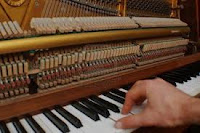 When it comes to the piano sound itself, Yamaha has a new sampled acoustic sound not found in their other digital pianos which they call CFX sampling using 256-note polyphony, and in my opinion this new piano sound sample is better than what’s in their higher priced AvantGrand N series in certain ways. It’s really a very pleasing tone and well done utilizing some advanced sampling technology and taken from Yamaha’s best acoustic grand pianos. However, even though the piano sampled sound itself may be inherently good and realistic, the piano needs an excellent & well positioned internal speaker system for the sound to be heard correctly, and unfortunately that’s one of the weak points of the NU1 in my opinion. The audio power in this model is super big and loud (if you want it to be loud) at 160 watts total (four 40-watt amps) into 4 speakers. In fact when you turn up the volume, it can difficult to play the piano softly or quietly because the minimum volume when playing the keys softly comes in a bit too loud and kind of jumps out at you…at least this was my experience playing it. So at louder volumes, the NU1 volume dynamics are not like a real acoustic upright piano when playing normally on regular settings. Also, when you’re sitting at the piano it seems like most of the sound comes out under the piano keyboard where your legs & feet are and then goes out into the room without the player getting the full effect of what a good console piano should sound like. If you think about it, an acoustic vertical piano such as the one pictured below left (which this NU1 is trying to replace) has hammers which strike the strings nearer to the upper middle of the piano (above where your hands are playing) and resonating/amplified through the soundboard behind the
When it comes to the piano sound itself, Yamaha has a new sampled acoustic sound not found in their other digital pianos which they call CFX sampling using 256-note polyphony, and in my opinion this new piano sound sample is better than what’s in their higher priced AvantGrand N series in certain ways. It’s really a very pleasing tone and well done utilizing some advanced sampling technology and taken from Yamaha’s best acoustic grand pianos. However, even though the piano sampled sound itself may be inherently good and realistic, the piano needs an excellent & well positioned internal speaker system for the sound to be heard correctly, and unfortunately that’s one of the weak points of the NU1 in my opinion. The audio power in this model is super big and loud (if you want it to be loud) at 160 watts total (four 40-watt amps) into 4 speakers. In fact when you turn up the volume, it can difficult to play the piano softly or quietly because the minimum volume when playing the keys softly comes in a bit too loud and kind of jumps out at you…at least this was my experience playing it. So at louder volumes, the NU1 volume dynamics are not like a real acoustic upright piano when playing normally on regular settings. Also, when you’re sitting at the piano it seems like most of the sound comes out under the piano keyboard where your legs & feet are and then goes out into the room without the player getting the full effect of what a good console piano should sound like. If you think about it, an acoustic vertical piano such as the one pictured below left (which this NU1 is trying to replace) has hammers which strike the strings nearer to the upper middle of the piano (above where your hands are playing) and resonating/amplified through the soundboard behind the
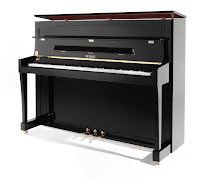 |
| Acoustic piano with open top |
piano. When this happens you hear a great amount of piano sound resonating and coming out towards your ears and not only down at your legs. The same would be true on a regular acoustic grand piano where the hammers strike the strings and you hear much of that sound above your waste & hands as opposed to coming out at your legs or feet. Although the NU1 does have real piano hammers moving inside the piano, you need to understand there are NO strings in this NU1 piano…the piano sound is activated electronically by the hammers moving and triggering the optical key sensors in the action with the piano sound coming out through a built-in speaker system. I just don’t feel I get the full resonating piano sound effect out of the NU1 that I do with a comparable Yamaha upright acoustic piano. The sound should mostly be coming at you and around your ears from approximately where the key action is moving inside as opposed to mostly coming out of speakers below your waste. In fact, on many models of acoustic vertical pianos you can open/prop up the top slightly (above left pic) to let out even more piano sound which does make a noticeably improved difference in hearing and feeling the overall piano tone. That’s why grand piano lids mostly stay open, so the sound is not stuck inside the piano…make sense?:). The NU1 lid does not open and therefore sound cannot come out in that way, which is unfortunate.
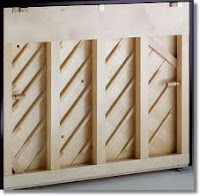 |
| acoustic piano back soundboard |
Because of all this, I felt a bit of a “disconnect” when playing the NU1 through its own speakers (as opposed to through headphones which was much better) because I wasn’t feeling & experiencing the piano sound and the way it came out like I do on a regular upright or console piano. Also as I just mentioned, on an acoustic console or upright piano, there is a full size wood sound board on the back of the piano (left pic) which allows the organic piano sound to naturally vibrate and travel through the grains of the wood (usually solid spruce wood) up to near the top of the piano, but this cannot happen on the NU1 because it has no wood soundboard, only speakers. But that would be true of most (but not all) digital pianos so the NU1 is no exception. For someone who is listening to the NU1 in another part of the room while another person plays the piano, then the piano does sound full and resonate because of how sound travels out into the room. But up close & personal, in my opinion the NU1 needs help reaching the players ears in a more natural way. It’s interesting that when using a good pair of stereo headphones, the piano sound fullness and quality is really enjoyable and is inside your ears (obviously) and there are many people who will be playing the NU1 through headphones, so the headphone listening experience does take care of the internal speaker issue…at least it does for me. The overall piano tone, the pedal sustain time, the natural damper resonance, dynamic tonal range, pedaling movement & functions, and other sound elements are quite good in this price range, but not perfect. I just happen to know what a real good acoustic piano sounds like when playing it and how the sound comes out and how it makes you feel, so I am a bit more critical in this way.
With only 5 instrument sounds (1 full stereo grand piano, one brighter basic piano, 2 nice electric pianos, a very nice pluck harpsichord), and basic digital functions (such as reverb, touch sensitivity levels, & a metronome) mounted in the side block to the left of the keyboard, the NU1 is very limited technologically in that way, but it obviously wasn’t designed to compete with all the extra digital piano and feature technology out there in other models and brands with lots of sounds, multi-track recording and playback, General MIDI, MP3 audio, etc. Unfortunately, the user display is just a small, simple LED screen with numbers instead of having a more understandable and user friendly multi character LCD display such as what is on the new Yamaha Clavinovas. Yamaha obviously did that to make this piano as minimalistic as possible and some people will like that and some people won’t, it just depends on what you want. There is a also USB flashdrive input under the front of the piano so that you can
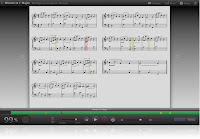
connect a flashdrive to it and save your recordings and play them back. The piano volume knob is also underneath the front of the piano so that it is hidden to provide that minimalistic look (a nice touch). There is also 1/4″ audio inputs, 1/4″ audio outputs, MIDI connectors, and a USB to computer or iPad connection. I happen to use an iPad quite a bit in my studio and connect to my digital pianos for educational and song practice apps. If you put an iPad in front of you on the NU1 you’ll need to connect it with a USB cable going over the side or over the top of the piano and then into the connectors under the front of the piano….unfortunately that won’t look too pretty, and in this day of Bluetooth technology the NU1 is definitely behind in this area which is another shortfall and would have solved the cable issue some ways, especially for a piano like this.
When it comes down to what you are getting for the money, for many people, the NU1 does deliver an elegant look with a slow close key cover and chrome pedals with half-damper function, very good piano tone (especially through headphones), minimalistic sophistication, and above all, an excellent wood vertical key action movement (not grand action) which is much better than the Yamaha Clavinova series, all in a small compact contemporary cabinet size. As I mentioned earlier, the NU1 does not have the height of a real upright piano since it is only 40″ tall. A real upright acoustic piano like the popular Yamaha U1 is 48″ tall so the NU1 digital piano is much shorter and more like a small console piano in height as I mentioned earlier. It is good to keep this in mind so you do not think this actually reproduces the same size as an upright piano. However, the sound is not generated by the bigger hammers, bigger upright piano strings, or large soundboard of a taller acoustic upright piano because the NU1 sound is produced 100% digitally so it does not need to be bigger and/or taller than what it is…except maybe to have extra room for an internal speaker system that would produce a more realistic acoustic sound experience, as I mentioned earlier. If Yamaha had designed in a top internal speaker system coming up and out of a grill on the top of the piano (Kawai has done that), then things would have definitely have been improved in my opinion.
| NU1 |
The NU1 does not have the new synthetic ivory keytops like on the Clavinova series (it uses acrylic resin white keytops like regular acoustic pianos), nor does it have the duet 4-hand function which splits the piano keyboard in two equal 44-key keyboards and lets two people play the piano at the same time in the same octaves (teacher student, etc). It also does not allow for layering of two instrument sounds together which is a big disappointment for me because I love to layer sounds, especially grand piano and strings. The NU1 does not have a string symphony sound (a favorite for many people)…and that is a big disappointment to me as well. With no strings and no layering, I cannot utilize the big 256-note polyphony in the NU1 and enjoy my favorite sound layer (grand piano and string symphony) as I do in so many other digital pianos.
| Yamaha NU1 w/closed key cover |
Is the NU1 something that can make many people happy who want nothing more than what I described which is basically a good console size piano, but with a few digital extras?…the answer would likely be YES. However, in my opinion the Yamaha company should have added some more height to this model and installed a more realistic sounding speaker system towards the top of the piano and also allow the top lid to be opened/propped up manually if needed which would address the sound issue of speaker placement and lack of “in your face” fullness. As another reviewer-writer in a known piano publication said in her NU1 review as compared to a Yamaha acoustic upright piano: *“whereas the U1 (a popular Yamaha acoustic upright piano) wrapped me in a blanket of sound, the NU1 produced
what was more like a column of sound that came at me as if through an
open door to a loud room — very focused, and a little canned.” “Next I tested the instrument using Yamaha HPE-170 headphones. This
time I found the sound to be rich and realistic, and very close to the
sound of the acoustic U1(acoustic piano).” The reviewer also said: “using only the built-in speakers, the decay of the NU1’s sound was
unlike that of the acoustic U1. I played a C octave on both instruments
at similar volumes, then timed their decays. The NU1’s sound lasted half
as long as the U1’s, and, rather than tapering off slowly, as an
acoustic instrument’s sound usually does, after several seconds it just
stopped.” I would agree with this reviewer on the points that she made (including pedal decay time) which is that the Yamaha NU1 does have some piano sound deficiencies, but as far as I’m concerned they are noticeable only if you know what to listen for and have had experience playing and listening to regular acoustic pianos which many people do not….and even if you did, you may not be bothered by these things because they may not be critical to you in the way you play & hear pianos.
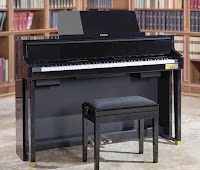
When it comes to buying and playing a digital piano, we all have different piano listening & playing experiences, different ears & frequency listening ranges, different finger muscle strength, different acoustic environments in our homes/rooms, and different playing skill levels. I do recommend the NU1 because it is really an impressive piano overall, even with its short-comings, and as I mentioned earlier, for many people I believe this hybrid wood key action piano will be a nice addition to any home for many years and can make owning a digital piano very enjoyable. If you want a digital piano that in my opinion offers a more upgraded key action in actual grand piano hammer movement, upgraded full dynamic range piano sound, then I would also recommend you consider the new Casio-Bechstein polished ebony Grand Hybrid GP500. The new 2016 Casio-Bechstein digital pianos use a newgrand piano movement with actual moving hammers in the piano. I have played and heard these new pianos and am very impressed so go to the following link for my review on the new “Grand Hybrid” pianos: Grand-Hybrid digital piano review
In the final analysis I would definitely recommend the Yamaha NU1 as a very good option in its price range, although I much prefer more digital features for this kind of money. As far as key action, piano sound, and pedaling authenticity goes overall I do enjoy playing the NU1 even with some of its deficiencies, although there are other digital piano models and brands that deliver a more authentic piano playing experience in my opinion. When anyone is looking to spend $5000 or more I always recommend to shop the different brands thoroughly and do your homework…you’ll be glad you did. Please contact me before you purchase any piano anywhere and I will give you free personal advice on which one may be best for your needs and your budget.
*quoted text in my review is from Rhonda Ringering in the Acoustic & Digital Piano Buyer publication Spring 2013.
If you want more info on new digital pianos and LOWER PRICES than internet discounts, please email me at tim@azpianowholesale.com or call direct at 602-571-1864.














I guess is better to not perfect because perfectness have a lot of disadvange
Tim – thank you very much for your outstanding reviews! I know it might be difficult to compare NU1 and Casio PX 850. How would you compare these two? Maybe at least from quality of sound and key action points of view?
wow, that's a really crazy comparison question:). That's like asking how a new Lexus SUV would compare to a new Toyota Corolla. Both are great in their price range but cannot be compared in any way other than appearance, and in the case of these pianos, even then the Yamaha is by far the better piano. Those 2 pianos are also about $3500 apart so it's not a fair comparison to begin with. I appreciate your comments but the NU1 is by far the better piano in every way as compared to the Casio PX850. If you have the money and like it, then buy it.
Hi Tim, which one is better the Yamaha NU1 or the Kawai CS10 which is also a hybrid piano? The NU1 looks very compact and it's probably better for small spaces. The CS10 would probably have the better key action as they use wooden keys plus the Grand Feel action with Let-off and Triple Sensor.
Tim,
I recently went to a Yamaha dealership here in Sarasota, Florida to try out the NU-1. I live in a condo and the ability to practice quietly or with headphones appeals to me.
The salesman informed me that the unit I played had just been placed on the floor (about two days earlier). Unfortunately, I discovered a recurring problem with it: certain notes, in various registers, were noticeably softer than others. I discovered this by playing a descending chromatic scale from the top to the bottom of the keyboard. When I pointed this out to the salesman, he did a soft reboot (which I guess amounted to depressing a key, turning the instrument off and powering it back up). The first time he did this, the notes that were softer previously were no longer softer….but others were. After another reboot, those keys were no longer softer but others were etc. When he did yet another reboot, two notes were noticeably louder than all the others.
The salesman was baffled. I was too. I guess there are two possibilities: 1). The problems described above were unique to the NU-1 I played or 2). These problems are common with all NU-1’s.
Can you offer any guidance here? $5000.00 is a lot of money for an instrument plagued with these deficiencies.
Many thanks,
Mark Schilling
Mark_schilling@verizon.net
very interesting as I did not notice this issue on the NU1's that I played. I will need to investigate further and answer your question after that. This may also be a good question for Yamaha tech support as possibly they have run into this issue before and have an answer. I would ask your salesperson to call them in the meantime. You might also want to try looking into another Yamaha model or another brand such as Roland or Kawai.
Hi, Tim…NU1 and Roland LX-15, which one you like?
Hi Tim, thanks for the detailed information on the NU1. Have you had a chance to play or review the Kawai CS10? From the info on their site, it looks like they have overcome some of the disadvantages you mention for the NU1. Any idea what the street price of the CS10 is? Thanks, Ben
The Kawai CS10 piano is the polished ebony piano cabinet version of the CA95. I have not done a review of the CA95 yet but I have played it and will do a review soon. However the CA95 is a very nice piano (both models) so I do recommend them
there are indeed two possibilities
1) that instrument needed to be (re)calibrated, as the optical sensors were in essence out of whack, literally.
2) DUST had gotten under the keys and interfered with the optical sensors. This is something that happens, just use some compressed air, or perhaps a vacuum to fix.
It seems that my NU1 had a similar problem. I bought it last year in Milan (Italy).
It happens sometimes some sound keys are softer than other and the piano must be switched off and on to solve it.
Does Yamaha has already solved the issue? Are there any solutions evailable?
Best Regards
Antonio
I always wanted a piano so on lonely nights I can just play it to myself or days I need to relax my soul. Thanks for sharing Tim, this helps me wake up!
Would a pair of tweeters on top of the piano help with the sound problem you are referring to? I am interested in this piano and wonder if this would be an easy solution.
tweeters only deal with higher frequencies and generally don't help the lower frequency tones and bigger volume. If external speakers were used to improve sound quality and sound position, then a good pair of powered full range bi-amped stereo monitors would be best
I have an NU1. I have found the computer appears to calibrate the keys during that initial period of time (3 seconds or so) between when you push the ON button and when the digital display shows numbers. If you press any key during that calibration period, those keys will ultimately sound much softer than all the other keys. As long as you don't touch any keys during the start-up calibration, the keys will all have the same volume when it comes time to play.
I live in a townhouse with thin walls — I have had the NU1 for 2 years and am still loving it.
I have a comment regarding … "The 40" height of the piano means that it is a console size piano and not a real acoustic type upright which is normally considered 48" tall."
Since this is a hybrid the actual height of the case is irrelevant. The more important question, is the action the same as a full sized upright?
I don't know the answer to that, but that should be addressed.
Tim, wonderful review. Very helpful for starters as myself. I practiced in one NU1 for a year and decided to buy one now. It is selling here in NYC for 6k new, and I found a 2-year old used one for 4900. Is this a good price? Any big concern about buying an used one? Any money I can save is welcome, but don't want this to be an unpleasant experience. Thanks, Thiago – tjsilva@stanford.edu